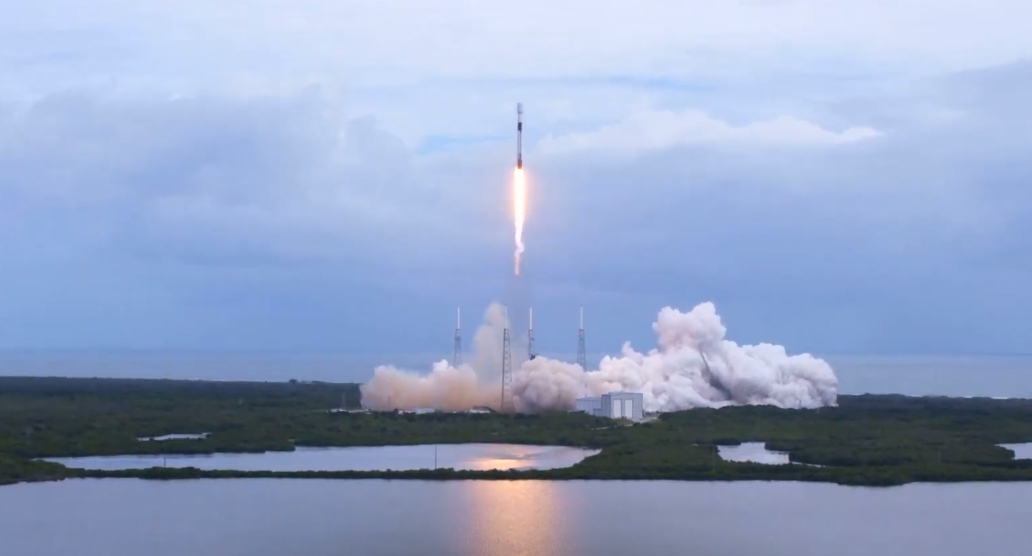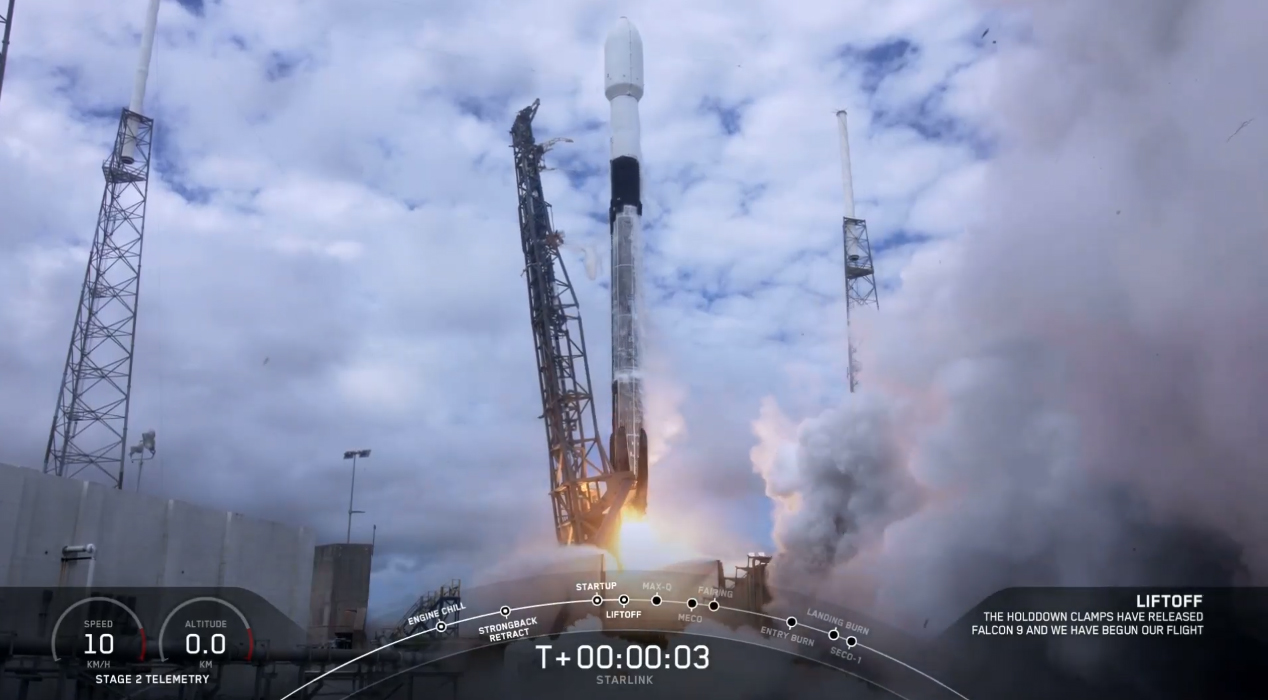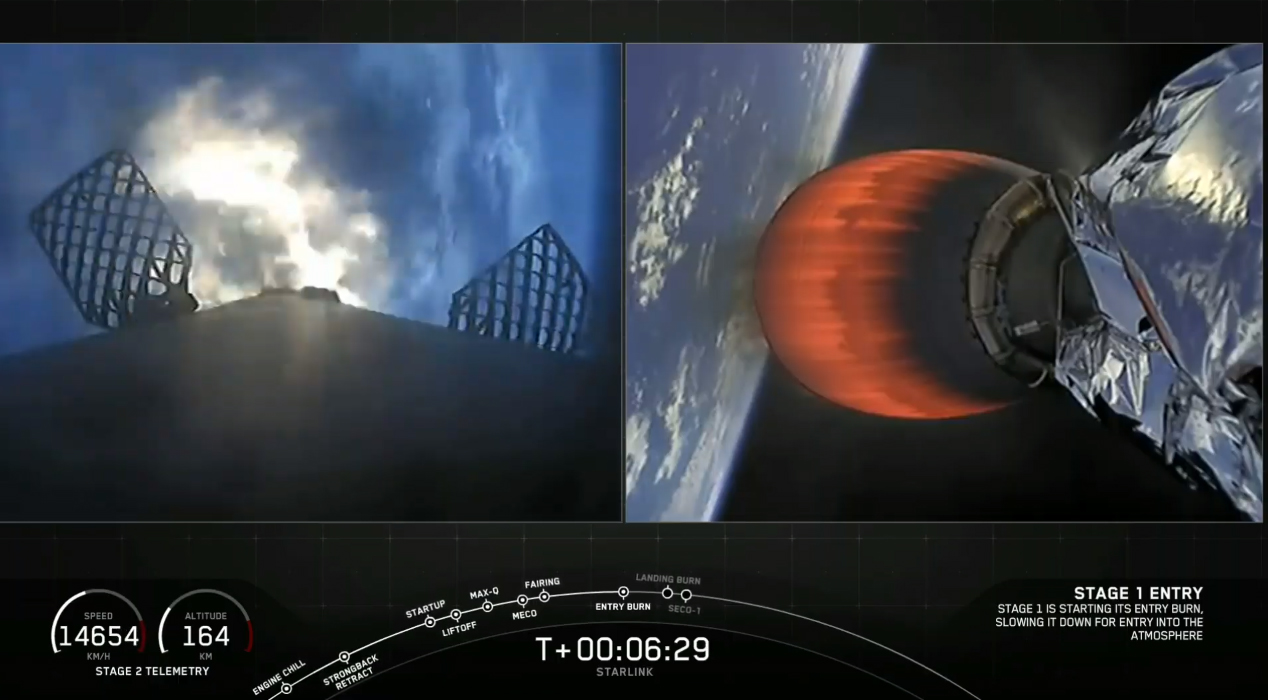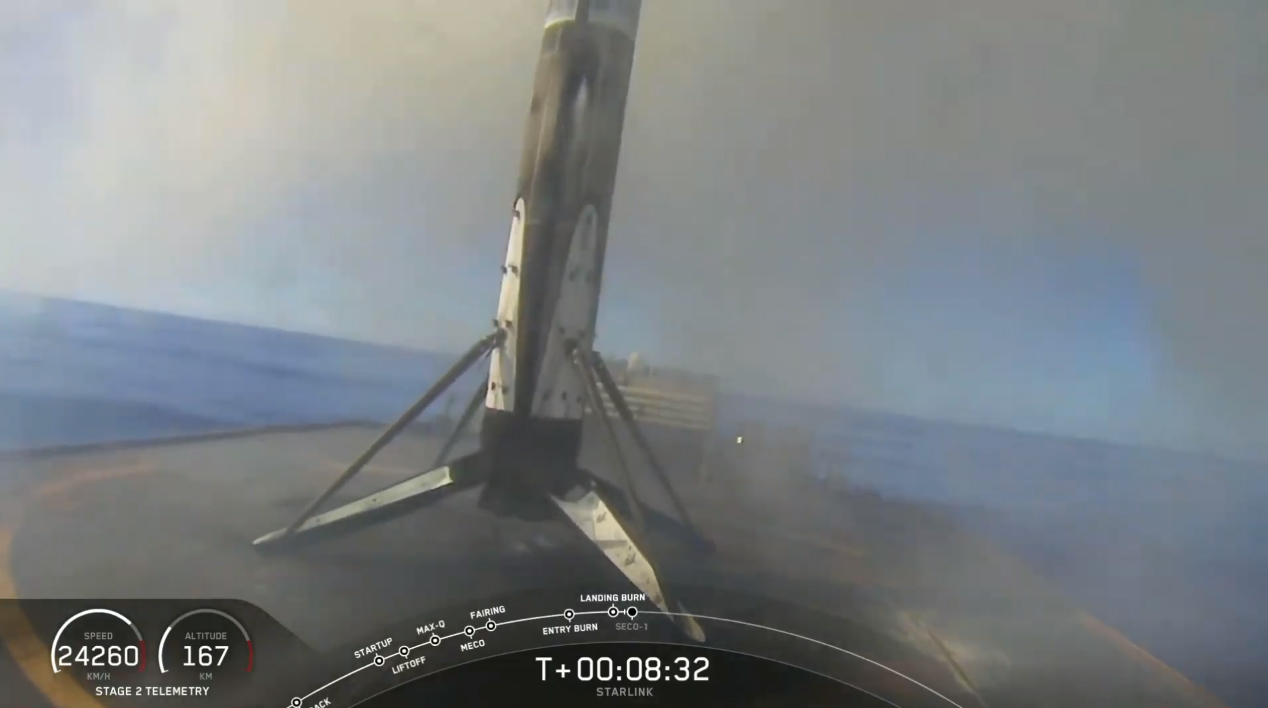SpaceX launches 60 Starlink satellites, lands rocket at sea in 2nd flight this week
That's 180 Starlink satellites launched in 7 days.
CAPE CANAVERAL, Fla. — California-based rocket builder SpaceX successfully launched its latest fleet of Starlink internet satellites into orbit Saturday (Oct. 24), marking the second such mission this week.
A previously flown two-stage Falcon 9 rocket blasted off from Space Launch Complex 40 here at Cape Canaveral Air Force Station at 11:31 a.m. EDT (1531 GMT) carrying a set of 60 new Starlink satellites for SpaceX's ever-expanding megaconstellation. Following an on-time liftoff, the company capped the mission with a successful rocket landing at sea.
Approximately 9 minutes after liftoff, the Falcon 9 booster's first stage returned to Earth, landing on one of SpaceX's drone ships in the Atlantic Ocean. The massive ship, Just Read the Instructions, is one of two booster catchers in the company’s fleet of recovery vessels.
Related: SpaceX's Starlink satellite megaconstellation launches in photos



SpaceX originally intended to launch this mission on Oct. 22, but chose to stand down in order to investigate technical difficulties with a camera on the rocket’s second stage. The two-day delay saw a slight improvement in the forecast with weather officials at the 45th Space Wing predicting a 60% chance of favorable conditions at liftoff. (The primary concern being cumulus clouds.)
But Mother Nature cooperated, with the Falcon 9 soaring into a mostly clear blue sky at liftoff. In the Atlantic, the booster's landing occurred under a crystal clear sky, according to SpaceX's video feed.
For this mission, SpaceX called on one of the newest members of its rocket fleet, B1060, to further expand its fleet of Starlink satellites. That booster first carried an advanced GPS satellite for the U.S. Space Force in June. This mission marks its second flight and the 63rd recovery of a Falcon first stage since SpaceX began its recovery efforts. It was the 11th successful landing on the drone ship Just Read the Instructions.
Get the Space.com Newsletter
Breaking space news, the latest updates on rocket launches, skywatching events and more!
SpaceX rocket rally
Today's flight is the 19th launch of 2020 for SpaceX and the 96th Falcon 9 flight to date. SpaceX is on pace for a banner year, as today’s mission brings the company just two launches shy of surpassing its previous launch record of 21 missions, set in 2018.
This achievement is made possible by SpaceX’s fleet of flight-proven boosters. Currently, SpaceX has five veteran boosters, and three brand new ones that are reserved for upcoming missions. For now, the company is only launching veteran boosters as it continues to work through an unexpected issue that cropped up during a recent launch attempt.
On Oct. 2, SpaceX called an abort seconds before the planned liftoff of an advanced GPS satellite. Data analysis showed an engine anomaly which resulted in SpaceX removing two engines from that booster and shipping them back to the company’s Texas-based facilities for further testing.

In an abundance of caution, SpaceX is also replacing one engine on two other missions slated to happen over the next few weeks.
On Wednesday evening, Kathy Lueders, NASA’s head of human spaceflight, tweeted that one engine was being replaced on the booster for SpaceX's upcoming Crew-1 astronaut flight and and the Sentinel 6 ocean-mapping mission. Both of these flights are set to launch in November and feature brand new boosters, just like the GPS mission. The repairs are not expected to impact launch dates, Lueders said.
In the meantime, SpaceX is focusing on its Starlink constellation, relying on flight-proven rockets to continue to fill in its planned initial set of 1,440. The engine issue seems to involve new boosters, which is why SpaceX is leaning heavily on its fleet of flight proven boosters to ferry its own satellites for the time being. If all goes as planned with the engine repairs, the next few weeks could be jam-packed with launches as SpaceX has a back-log of missions to get through.
Related: Hitch a ride to space (and back) on a Falcon 9 in this awesome video
A Starlink megaconstellation grows
SpaceX launched its Starlink internet service as a means to pay for its future Mars endeavors. The company needs expensive hardware and more advanced rockets and spacecraft, like its Starship project currently under development. To that end, the company is using a fleet of flat-paneled satellites to beam down high speed, low latency internet coverage, particularly to those in rural and remote areas.
SpaceX CEO, Elon Musk, has estimated that the Starlink service could generate as much as $30 billion a year, although no actual pricing has been announced yet. Currently, the burgeoning internet service is going through a private beta-testing program, with company employees putting it through its paces. Preliminary reports are promising, indicating that the Starlink network can support multiple high-definition streams at once.
A broader, public beta-test is set to roll out later this year before the service officially kicks off in North America and Canada. There are still regulatory hurdles the company needs to overcome, but with more than 800 of the broadband satellites in orbit, it is well on its way to start its initial service offerings.
The Starlink megaconstellation was designed to provide Internet coverage in those locations that currently don't have access. As such, SpaceX has qualified to participate in the Federal Communications Commission’s (FCC’s) Rural Digital Opportunity Fund (RDOF) Auction. The auction, which will take place on Oct. 29, will distribute $20.4 million over the next decade specifically to internet providers that connect locations currently without access to affordable internet service.
According to the FCC’s website, the first phase of the auction “will target over six million homes and businesses in census blocks that are entirely unserved by voice and broadband with download speeds of at least 25 Mbps.”
The fund will allow broadband carriers to bid on the rights to use that money to roll out broadband service in underserved areas, prioritizing tribal lands and regions that currently lack internet download speeds of at least 10 Mbps. The FCC estimates that roughly 6 million locations would be eligible for the first phase of the auction.
Related: Why SpaceX's Starlink satellites caught astronomers off guard
#TheFutureIsNowEC! We are joining the @SpaceX Starlink satellite constellation to provide high-speed, low-latency Internet to students. https://t.co/5guLw1YpmT @chiefsforchange #PermianStrategicPartnership pic.twitter.com/Tf72QHoWl4October 20, 2020
SpaceX builds its own Starlink satellites at a company facility in Redmond, Washington, where it also makes user terminals and ground stations. Despite still being in beta-testing, SpaceX has granted outside users access to its Starlink network.
In August, the company partnered with Washington State to provide emergency responders with reliable internet access as they battled wildfires in the area. The company also provided Starlink access to homes on the Hoh Native American reservation in western Washington, connecting residents who had no access to internet services.
But that’s not all, SpaceX is partnering with the Ector County Independent School District in Texas to provide free Starlink internet service to local students and their families.
SpaceX is also partnering with Microsoft’s Azure Space division to provide internet service to the new Azure Modular Datacenter (MDC), which is a contained unit that can be deployed anywhere, even "off the grid," creating remote connectivity access or supporting existing access.
Catching rocket nose cones
As part ongoing efforts to expand its recovery processes, SpaceX has outfitted two ships — GO Ms. Tree and GO Ms. Chief — with giant nets, serving as mobile catcher's mitts. The ships are then deployed to a specific landing zone each mission to either catch the fairings as they fall from the sky or scoop them out of the water after they return to Earth.
The fairings (also known as the rocket's nose cone) protect the payload as the vehicle travels through the atmosphere. The clamshell-like shroud has historically been a one-and-done piece of hardware, discarded in the ocean after each mission.
With the fairing pieces accounting for roughly 10% percent of the total cost of a Falcon 9, SpaceX estimates it can save as much as $6 million each flight by refurbishing and reusing the fairing pieces.
Recovery efforts typically happen about 45 minutes after launch. During the last launch on Sunday (Oct. 18), Ms. Chief snagged its fairing, but unfortunately suffered a damaged antenna in the process.
Ms. Tree also suffered some damage as its fairing half landed on one of the vessel’s outstretched arms, causing the net to give away. The boats spent the week docked in Morehead City, North Carolina as the damage required repairs, though Ms. Chief was on scene today to attempt a fairing recovery after they splash down in the water, SpaceX manufacturing engineer Jessica Anderson said during live launch commentary.
To help carry out its recovery efforts, SpaceX deployed two of its other ships, GO Navigator and GO Searcher. This duo left its home at Port Canaveral early Saturday morning, but not in enough time to arrive at the landing zone when the fairings do. They could still help scoop the halves out of the water later on.
he Starlink stack is scheduled to separate from its rocket upper stage about an hour after liftoff.
It’s unclear what's up next for SpaceX as the company is working through replacing some of its Merlin 1D engines on rockets slated to in the next few weeks. Those repairs stem from an engine anomaly that occured on Oct. 2, which prevented the launch of an upgraded GPS satellite from getting off the ground.
That issue also pushed back the launch of NASA's next astronaut crew. Victor Glover, Mike Hopkins, Shannon Walker and Soichi Noguchi are estimated to blast off to the International Space Station sometime before mid-November.
Follow Amy Thompson on Twitter @astrogingersnap. Follow us on Twitter @Spacedotcom or Facebook.
Join our Space Forums to keep talking space on the latest missions, night sky and more! And if you have a news tip, correction or comment, let us know at: community@space.com.

Amy Thompson is a Florida-based space and science journalist, who joined Space.com as a contributing writer in 2015. She's passionate about all things space and is a huge science and science-fiction geek. Star Wars is her favorite fandom, with that sassy little droid, R2D2 being her favorite. She studied science at the University of Florida, earning a degree in microbiology. Her work has also been published in Newsweek, VICE, Smithsonian, and many more. Now she chases rockets, writing about launches, commercial space, space station science, and everything in between.









